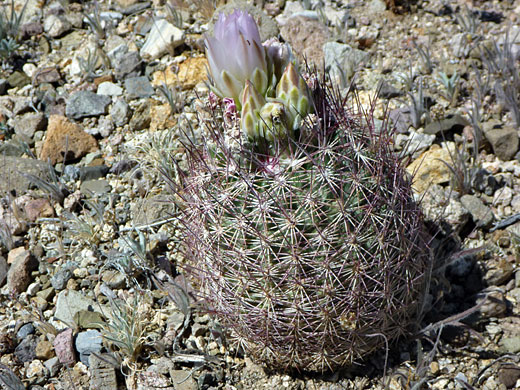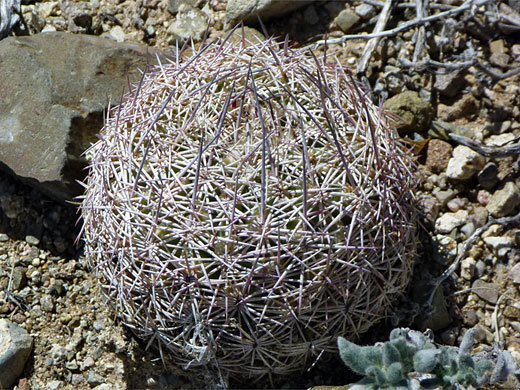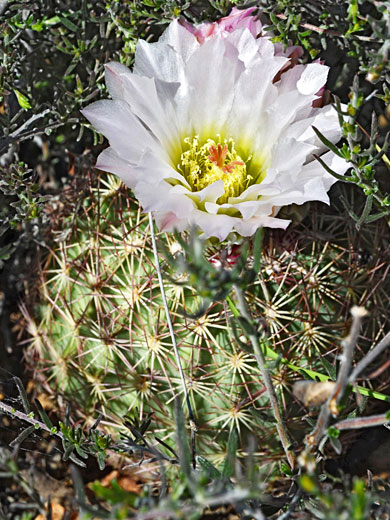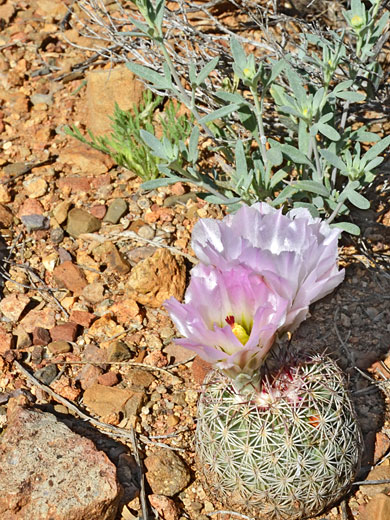Scientific name:
Echinomastus erectocentrus
Common name:
Redspine pineapple cactus, needle-spine pineapple cactus, Sonora pineapple cactus
Range:
Small areas in southeast Arizona
Form:
Squat cylinder, usually solitary
Habitat:
Grassland, scrubland, hillsides to 6,000 feet elevation
Flowers:
Pale pink, with yellow interiors and red stigmas

Distribution map for echinomastus erectocentrus
Echinomastus erectocentrus is named for the straight, upward pointing central spines (one per areole), mostly colored maroon-purple and about 1.5 inches long. Other spines also have purplish coloration at the tips; lower parts are grey or white. The plant has 18 to 21 narrow, tuberculate ribs bearing intersecting clusters of 12 to 18 radial spines, lying close to the stem surface, and 1 to 3 centrals, creating quite a dense network of spines that largely hides the green body. Stems may become 13 inches tall, but are usually no more than half this height.
Flowers grow from a tight circle right at the top of the plant, blooming in spring and followed by green fruits that become brownish when ripe. Stamens have thin yellow filaments and pale yellow anthers. Stigma lobes are red or brownish.
This cactus is quite rare, found in limited areas of south Arizona; near Florence, in Organ Pipe Cactus National Monument, and east of Tucson, from the valley of the San Pedro River to Sahaurita.
There are two varieties of echinomastus erectocentrus, var erectocentrus, concentrated around Tucson, and var acunensis mostly in other locations. The former has fairly inconspicuous central spines, usually one per areaole, and white or very pale pink flowers, while the latter has more prominent central spines, normally 2 or 3 per areole, and darker (pink) flowers.
Flowers grow from a tight circle right at the top of the plant, blooming in spring and followed by green fruits that become brownish when ripe. Stamens have thin yellow filaments and pale yellow anthers. Stigma lobes are red or brownish.
This cactus is quite rare, found in limited areas of south Arizona; near Florence, in Organ Pipe Cactus National Monument, and east of Tucson, from the valley of the San Pedro River to Sahaurita.
There are two varieties of echinomastus erectocentrus, var erectocentrus, concentrated around Tucson, and var acunensis mostly in other locations. The former has fairly inconspicuous central spines, usually one per areaole, and white or very pale pink flowers, while the latter has more prominent central spines, normally 2 or 3 per areole, and darker (pink) flowers.
All Contents © Copyright The American Southwest | Comments and Questions | Contribute | Affiliate Marketing Disclosure | Site Map







